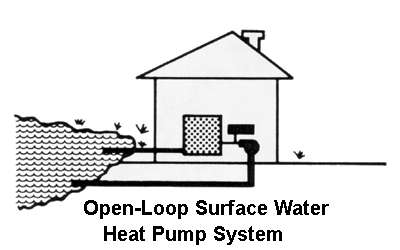You are here
 bge.apogee.net
bge.apogee.net
An open-loop, ground-water heat pump, uses a surface or underground water source (such as a lake, river, or well) as the heat source and sink. Well water designs are the most common and seem to be the most cost effective. The well supplies both domestic water and water for the heat pump. Approximately three gallons per minute of well water are needed per ton of cooling capacity.
Ground water source open-loop heat pumps use the same concept as the ground coupled units - for example, in the Midwest the temperature of the earth near the surface and the water in it (aquifer) is typically around 55°F. Water is taken from the ground or surface water (pond, lake, etc.), circulated to the individual heat pumps and the returned to the ground via a disposal well, returned to the lake or pond, or where permitted discharged into a stream or river.
When more units are heating than cooling the circulating water temperature drops prior to disposal. Conversely, when more units are cooling than heating, the circulating water is warmed prior to disposal.



Recent Comments